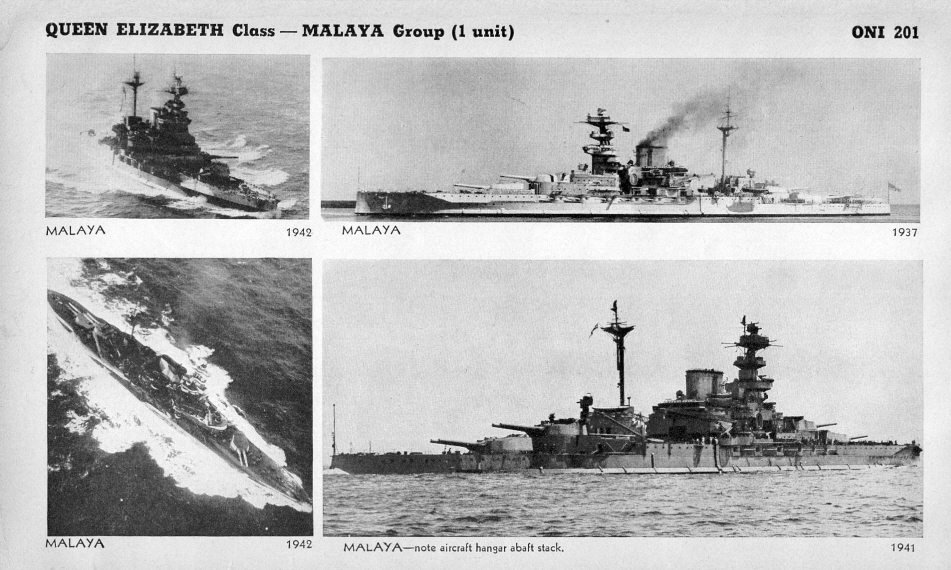HMS Malaya (BB-6)
British Battleship of WW1 and WW2
By Stephen Sherman, June, 2007. Updated March 1, 2012.
HMS Malaya was a Queen Elizabeth class battleship of the Royal Navy, launched in March 1915. She was named in honour of the Federated Malay States, whose government paid for her construction.
Built by: Armstrong (Newcastle-on-Tyne)
Ordered: 1913
Laid down: 20 Oct, 1913
Launched: 18 Mar, 1915
Commissioned: 1 Feb, 1916
Complement: 1,124 to 1300 approx.
Armament: eight 15-inch guns, twelve 6-inch guns, eight 4-inch A.A guns, sixteen 2-pdr AA guns, and 1 aircraft.
Speed: 24 knots,
Displacement: 31,100 tons.
Battle of Jutland 1916
Fired 215 15-in rounds. Received 7 12-inch hits and sustained 63 killed and 68 injured.
24 June 1916 rejoined Grand Fleet after repairs.

Rebuilt twice between wars. The latter rebuild saw the addition of a new hanger and fixed catapult aft of the funnel, two cranes were provided to support the movement of the aircraft. The single 4" AA gun mounts were replaced by twin mounts. Two 8-barrelled pom pom's were provided and two quad 0.5" machine guns were mounted on X turret. Two HA DCT (High Angle Director Control Tower) were fitted to support the new anti-aircraft guns.
Following the start of the war a new air warning radar was fitted, a surface radar, and a Type HA (High Angle) radar. Some 20 additional 20 mm Oerlikon guns were added.
World War Two
17 Aug, 1940 - In the early morning the British battleships HMS Warspite (Capt. D.B. Fisher), HMS Malaya (Capt. A.F.E. Palliser), HMS Ramillies (Capt. H.T. Baillie-Grohman) and others bombarded the Italian positions around the fortress of Bardia.
Operation MB-6 - 8 Oct, 1940
A British convoy of four merchantmen left Alexandria for Malta on 8 October 1940. This convoy was escorted by two British anti-aircraft cruisers, three Australian destroyers HMS Stuart, and one British destroyer.
Cover was provided by the Mediterranean Fleet (under Admiral Cunningham) with the British battleships HMS Warspite (Capt. D.B. Fisher), HMS Valiant (Capt. H.B. Rawlings), HMS Malaya (Capt. A.F.E. Palliser), HMS Ramillies (Capt. H.T. Baillie-Grohman), the British aircraft carrier HMS Illustrious (Capt. D.W. Boyd), and other British and Australian warships.
The convoy was not spotted and arrived safe at Malta on 11 October. The only damage sustaned was to the destroyer HMS Imperial that was mined off Malta and was out of action for over 6 months.
While on the return trip the Mediterranean Fleet was sighted by an Italian aircraft. The Italian Navy tried to intercept them in the Ionian Sea. In the night of 11/12 October Italian torpedo boat and destroyer flotillas attacked, but were repulsed with heavy losses.
British raid on Genoa - 6 Feb, 1941
Force H (under Vice Admiral Somerville) left Gibraltar on 6 February 1941. The battlecruiser HMS Renown (Capt R.R. McGrigor), battleship HMS Malaya (Capt. A.F.E. Palliser), aircraft carrier HMS Ark Royal (Capt. C.S. Holland), and other ships left Gibraltar to the west with convoy HG-53. This was done to fool German and Italian observers in Spain. In the meantime 4 destroyers left Gibraltar and steamed to the east to conduct a anti-submarine sweep. During the night Force H reversed course and passed Gibraltar on a westerly course back into the Mediterranean. There they were joined by the 4 destroyers.
On 8 February the Italian fleet left port and steamed south after they received reports of British carrier aircraft south of the Balearics. The Italians thought that there was another convoy to Malta.
Early in the morning of 9 February, Renown, Malaya and Sheffield bombarded the Italian city of Genoa. In the harbour 4 ships were sunk and 18 were damaged. Also the city itself was damaged. The Italian fleet turned around and tried to intercept the British ships but due to the bad weather this failed. In the meantime Ark Royal's aircraft raided Livorno and mined the harbour of La Spezia. Force H safely returned to Gibraltar on 11 February.

20 Mar, 1941
Just before midnight, the German submarine U-106 attacked a merchant ship of the convoy SL-68 with a spread of two torpedoes about 250 miles west of the Cape Verde Islands. One torpedo hit and damaged the British battleship HMS Malaya, causing considerable damage. With extensive flooding, the ship took a list of 7 degrees, but safely reached Trinidad. After temporary repairs were made, she contined to the New York Navy Yard, where the battleship was docked for 4 months. On 9 July, the ship left for the Clyde, arriving on 28 July.
In 1942 the aircraft and catapult were removed and two twin 4" AA gun mounts were added to the flight deck, two more 8 barrelled pom poms were added on the aft superstructure, the number of 20 mm Oerlikon cannons was increased to 31. A type (SW) 271 radar was added atop the foremast. The two forward 6 inch guns were removed.
HMS Malaya was withdrawn from service at the end of 1944 and placed in reserve and served as an accommodation ship. Sold on 20 February 1948 to Metal Industries and arrived at Faslane on 12 April 1948 for scrapping. . She was scrapped at Faslane in Scotland on the 12th April 1948. The ships bell can be seen in the East India Club, London.
Photos: here.
